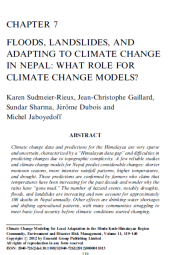Floods, landslides, and adapting to climate change in Nepal: What role for climate change models?
Summary
This paper examines the existing gaps between current climate models and the realities of local development planning through a case study on flood risk and drinking water management for the Municipality of Dharan in Eastern Nepal. This example highlights challenges facing local-level governments, namely, flood and landslide mitigation, providing basic amenities – especially an urgent lack of drinking water during the dry season – poor local planning capacities, and limited resources. In this context, the challenge for Nepal will be to simultaneously address increasing risks caused by hazard events alongside the omnipresent food security and drinking water issues in both urban and rural areas. Local planning is needed that integrates rural development and disaster risk reduction (DRR) with knowledge about climate change considerations.
It concludes with a critical analysis of climate change modeling and the gap between scientific data and low-tech and low capacities of local planners to access or implement adequate adaptation measures. Recommendations include the need to bridge gaps between scientific models, the local political reality and local information needs.
Categories:
Journal
Publisher:
Research Gate
Published Year:
2012
